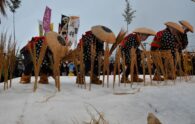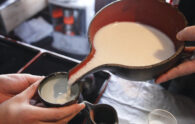The great warrior Benkei sought to obtain 1000 swords; each from a warrior he defeated. He had gathered 999 when one fateful day he encountered a man by the name of Yoshitsune on Gojo Bridge in Kyoto…
Swords were an integral part in shaping the history of Japan. In the Ichinoseki region, one of the oldest groups of swordsmiths, the legendary Mokusakaji made Mokusa Swords, which are said to be an indispensable part of the Japanese sword’s origins. Mokusa Swords, which were also popular among the aristocrats of Kyoto, are thought to have helped sustain the military power of the Oshu Fujwara Clan (1087-1189) who ruled the Tohoku Region and were one of the four great clans during the Heian period(794 to 1185).
Japanese Swords
People often refer to Nihonto or Japanese swords as the swords forged after the Heian period with a curved, single edge blade. The traditional material that Japanese swords are crafted from is called Tamahagane, rare steel comprised of iron-sand with unevenly distributed and high carbon content that needs to be purified by a number of processes by the swordsmith. Japanese swords reached their prime during the Kamakura period (1185–1333) with swordsmithing techniques so profound that some swords of those times cannot be reproduced with modern technology: this is referred to as ‘lost technology’.
Chokuto and Warabiteto
The predecessor to the Japanese sword was the chokuto (a long, straight sword) used mainly to stab. Another style of sword was the shorter warabiteto that had a curved hilt as the blade faces upward making it better suited for cutting. The warabiteto is said to be the earliest sword discovered with curvature and had been used since the 8th century in Tohoku. Although found across Japan, only a few have been discovered in western Japan. They were most common in the Tohoku region with a large amount excavated in Iwate Prefecture; the reasons being that there was a prominent and strong group of Emishi (an ethnic group who lived in Northern Japan) in the area who preferred to use warabiteto, as well as the abundance of materials such as high quality iron-ore and iron sand – essential for crafting swords.
The link between Mokusa Swords and Japanese swords (nihonto)
The Japanese sword’s curve originated from the warabiteto. The Mokusakaji inherited the work of the warabiteto swordsmiths and were active swordsmiths during the developmental phase of Japanese swords, bringing forth the connection between Mokusa swords and the origins of the Japanese sword.
Mokusa swords are the swords that were made in the Mokusa district of Ichinoseki. The Mokusa Shrine (718AD) is thought to have been a workplace of the Mokusakaji. An excavation survey discovered traces of steel and tools such as tuyeres and sickles around the shrine. A wealth of source material such as iron and trees to make charcoal to heat steel existed in the area.
The elusive history of the Mokusa sword
With the fall of the Oshu Fujiwara came the decline of the Mokusa swordsmiths with only a few Mokusa Swords existing today. Much of the history of the Mokusa sword is shrouded in mystery. Although Mokusa’s great reputation is evident in historical literature, no Mokusa Sword with a reliable inscription from the Heian Period has been handed down over the generations. Although one would expect to find Mokusa Swords in the Hiraizumi area, after excavation efforts, Mokusa swords have yet to be found there. This one on display is from the Kamakura period.
The Ichinoseki City Museum
The Ichinoseki Museum has exhibits introducing the swords, how they are crafted and related artifacts in chronological order. The swords are as beautiful as new thanks to the work of Togishi who grind and polish the swords to restore their original sheen.
Japanese
~日本刀の源流のひとつ「舞草刀」~弁慶は、通りかかった武士から1000本の刀を奪うという目標を立て、毎晩京都をさまよったと言われています。999本の刀を集めて、1000本目を奪おうとした時、京都の五条大橋で源義経に出会った…
刀は日本の歴史を形作る上で欠かせないものでした。一関地域で活動していた日本の最も古い刀工群のひとつである舞草刀工について紹介します。
舞草刀工による「舞草刀」は日本刀の源流のひとつと言われています。京都の貴族の中でも評価が高かった舞草刀は東北を支配していた奥州藤原氏(1087-1189)を支えた刀と考えられています。
日本刀
一般に日本刀と呼ばれるものは、平安時代(794年~1185年)後期に現れた、反りがあり刀身の片側に刃がある刀剣のことをいいます。 日本刀の原料は玉鋼です。 玉鋼は砂鉄から作られた合金で、炭素含有量が高い鋼です。 含まれている不純物も刀工による工程を経て製錬されます。 日本刀は鎌倉時代(1185 - 1333) に黄金期を迎えました。 一部の日本刀は現代の技術でも再現ができない「ロストテクノロジー」とも呼ばれ、古来より高い技術を誇っていたことを示しています。
直刀と蕨手刀
日本刀として完成する以前の刀剣は「直刀」で主に刺すことに使用されていました。 もう一つは「蕨手刀」です。 東北地方において、8世紀頃から使用されていたと考えられる蕨手刀の刀身の柄の部分は反りあがっており、たち切ることに適していました。 この蕨手刀の出土数は全国的に見ても岩手県が圧倒的に多く、その理由は、この地に多く存在していた蝦夷と呼ばれる人々が好んで蕨手刀を使用していたためと推察されます。 また、刀の製作に欠かせない高品質の鉄鉱石や砂鉄などの豊富な素材が多かったとも考えられます。
舞草刀と日本刀の関係
日本刀の反りは蕨手刀から生まれていると言われているため、日本刀の完成には蕨手刀の存在はなくてはならないものでした。そんな蕨手刀の刀工たちの業を受け継ぎ、日本刀の原型が出来るころに活躍していたのが舞草刀工です。このことから、舞草刀は日本刀の源流の一つと言われています。
[写真1]
舞草刀は一関市舞草地区付近で刀工たちが作った刀の事を言います。仕事場の一つとして考えられているのが一関市舞草地区にある舞草神社(718)です。発掘調査の結果、神社周辺で鉄鋼や羽口、鎌などの道具の痕跡が発見されました。この地域には、鉄や鋼を加熱するための炭となる木が豊富でした。
舞草刀の謎
舞草刀の歴史の多くの部分が謎に包まれています。 文献上には優秀性が記録されていますが、平安時代のものであるという在銘が確実な舞草刀は伝世されていません。 また、実物の舞草刀は少なく、平泉での発掘作業でも刀剣が未だ出土されていません。 こちらの舞草刀は鎌倉時代のものです。
[写真2]
一関市博物館
一関市博物館では舞草刀や、刀作りの工程、関連する工芸術品が年代順に展示されています。 研ぎ師の腕で錆びた刀を綺麗にし、元の磨き上げられた状態に仕上げています。
[写真3]





-195x124.jpg)
